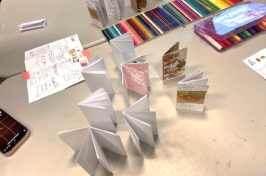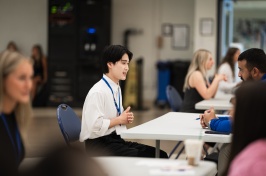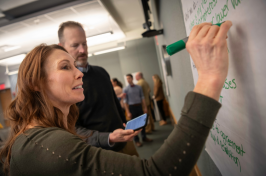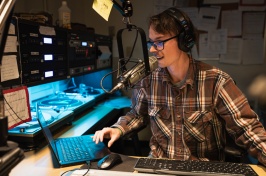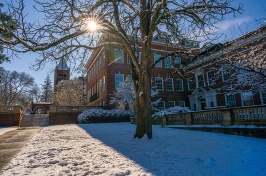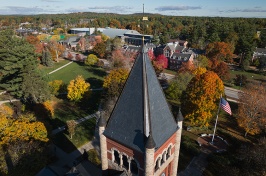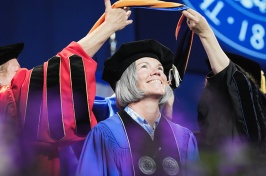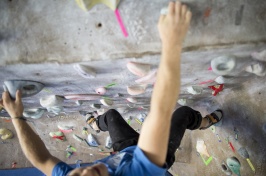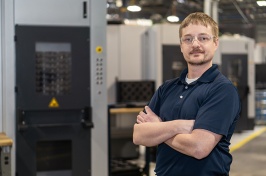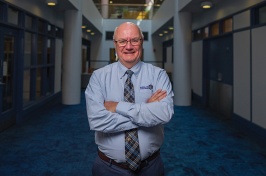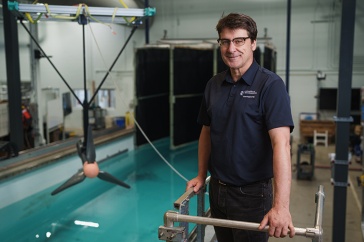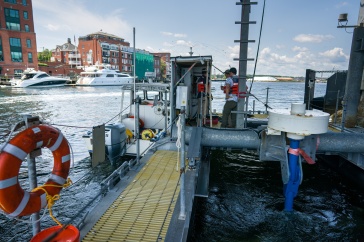
Zach Yeaton ’26 in the cockpit of the ultralight aircraft built by a team of UNH engineering students.
After pouring so much time and effort – an estimated 6,000 man-hours – into a single project and spending what seemed like every waking minute as close to it as possible for the last year, five UNH students found themselves watching the ultimate culmination of that work from about a quarter mile away.
The more distant vantage point, though, did little to dampen the adrenaline – or the significance of the achievement.
Five UNH engineering students watched the ultralight electric aircraft they conceived, designed and built officially take flight last month, marking the successful completion of a senior project so ambitious and groundbreaking that faculty adviser Ivaylo Nedyalkov said it has “redefined what's possible.”
It is believed by Nedyalkov and the students to be the first time ever that an undergraduate student team conceived, built and flew its own custom-designed electric aircraft, all within the span of one academic year.
“Very few student projects – at UNH or worldwide – can match the scope, technical depth and level of completion we saw with this ultralight aircraft,” says Nedyalkov, senior lecturer in mechanical engineering. “This team has set the bar exceptionally high. They’ve shown that with the right mix of vision, drive, discipline and teamwork, students can take on challenges that many would consider out of reach.”

For the students – Marcus Herold ’25, Ethan Tillinghast ’25, Seth Chartier ’25, Philip Mather ’25 and Brian Viscido ’25 – watching the first test flight take off and land safely was an energizing culmination of months of hard work and long hours. Though they had to view the flight from a distance for safety purposes, little could have changed the gravity of the moment.
“We were more than a quarter mile away from it, so it was kind of hard to see what was happening, but you could tell it got off the ground. It was pretty unreal,” says Herold, the team lead and visionary of the project. “Everybody dumped a lot of their time and energy into making this happen. It’s been a long-term goal of mine – I’ve always wanted to build a full airplane – so to see it happen was quite awesome.”
The aircraft was flown by Zach Yeaton ’26, a fellow UNH student who has his pilot’s license. Yeaton guided the ultralight down the runway before lifting off, getting about 10 feet off the ground and flying for just over 10 seconds – the proposed height and duration parameters proposed for the flight due to safety considerations – before touching down safely (you can see the test flight and hear from team members in this video.)
It was the initial test flight for the students after spending so much time crunching numbers and revising specifications to ensure maximum safety.
“What made it even more remarkable was that they succeeded on the very first day they brought the plane to the airport,” Nedyalkov says. “More than anything, I felt genuine joy for the students. They worked hard and fully earned that moment of celebration.”
It was a long time coming. After the team pitched the idea at the beginning of the spring semester in 2024 and Nedyalkov signed off, the members dived into the process by composing a detailed proposal before building a functional quarter-scale model (“making a strong case that this wasn’t just an ambitious idea – it was a realistic and achievable goal,” Nedyalkov says).
From there, they set out to complete the official structure. The entire project, start to finish, was designed by the students, and they also manufactured and assembled essentially all of the parts. Aside from a few components like the motor, propeller, wheels, brakes and battery cells, the students built everything themselves – including the wings, fuselage, empennage, landing gear and control surfaces.
Many of the parts were made using a 3D printer, they said, while others were created with a waterjet cutter that cuts out pieces of sheet metal that can be bent into any necessary shapes. The students also cut pipes by hand and welded them together to form parts of the frame and did a lot of woodworking, as well.
To qualify as an ultralight, the aircraft had to weigh less than 254 pounds – a challenge made even tougher by the team’s commitment to making it electric (gas-powered planes lose weight as they fly as fuel burns off, while electric components can be heavier and remain a static weight).
The team noted that so many other modes of transportation – like cars, trains and bikes – had successfully implemented electric power, so aviation was the next logical, albeit daunting, frontier.
“Electric aviation is in the near future. It’s not as far away as people might think it is,” says Tillinghast. “Our main goal was to prove that it can be done and be done at a relatively reasonable cost.” The project cost about $8,000 in total, he says.
Adds Herold: “That certainly made it a much larger engineering challenge. There would have been lots of benefits as far as the engineering side to make it gas-powered, but we really wanted to try to show that it could be done, that you can fly with an electric power system. I also think it puts a good foot forward for the university, thinking about sustainability and looking toward the future.”
As the aircraft came together, the challenge of keeping the weight down landed more and more on Chartier’s shoulders, as he was responsible for constructing the landing gear and making it maximally safe while adding as little heft to the design as possible.

“I did a lot of different designing, and I was constantly trying to shave off as much weight as I possibly could while still making sure it could withstand the impact,” says Chartier, who during that process adapted the design to move from steel springs for suspension to bungee cords.
“It got to the point where that was the only thing we could change to save weight. He kept giving us new designs and we kept handing them back and saying, ‘we need you to make it lighter.’” Tillinghast quips.
The focus on maximum safety also required making the frame a little heavier than it otherwise could have been, as the team opted for a sturdier roll-cage style frame to protect the pilot that “came at a cost of a little bit of range,” limiting the distance the aircraft could fly before touching down.
All the calculations and revisions and the late nights making sure everything was in order were worth it to see the aircraft fly, the team says. It was a particularly bold venture – Herold noted that other student teams around the country have retrofitted electric aircraft, pulling the original gas-powered engine out of an existing structure and adding electric components, but there is no record of a team designing and building one from the ground up in a single academic year.
Nedyalkov backs up the assertion that the project was truly trailblazing, and he remains in awe of what the students were able to accomplish.
“I can’t overstate how impressive this project is—not just for UNH, but globally. This is the kind of hands-on experience that defines a top-tier engineering program and shapes the engineering leaders of tomorrow,” Nedyalkov says. “We’re fortunate to have students with this level of talent and ambition, and I’m proud that UNH provides an environment where even the sky isn’t the limit.”
-
Written By:
Keith Testa | UNH Marketing | keith.testa@unh.edu

